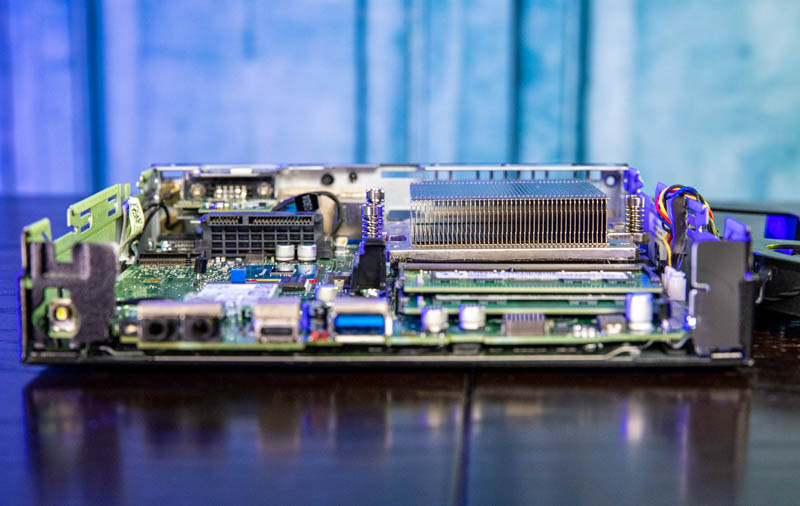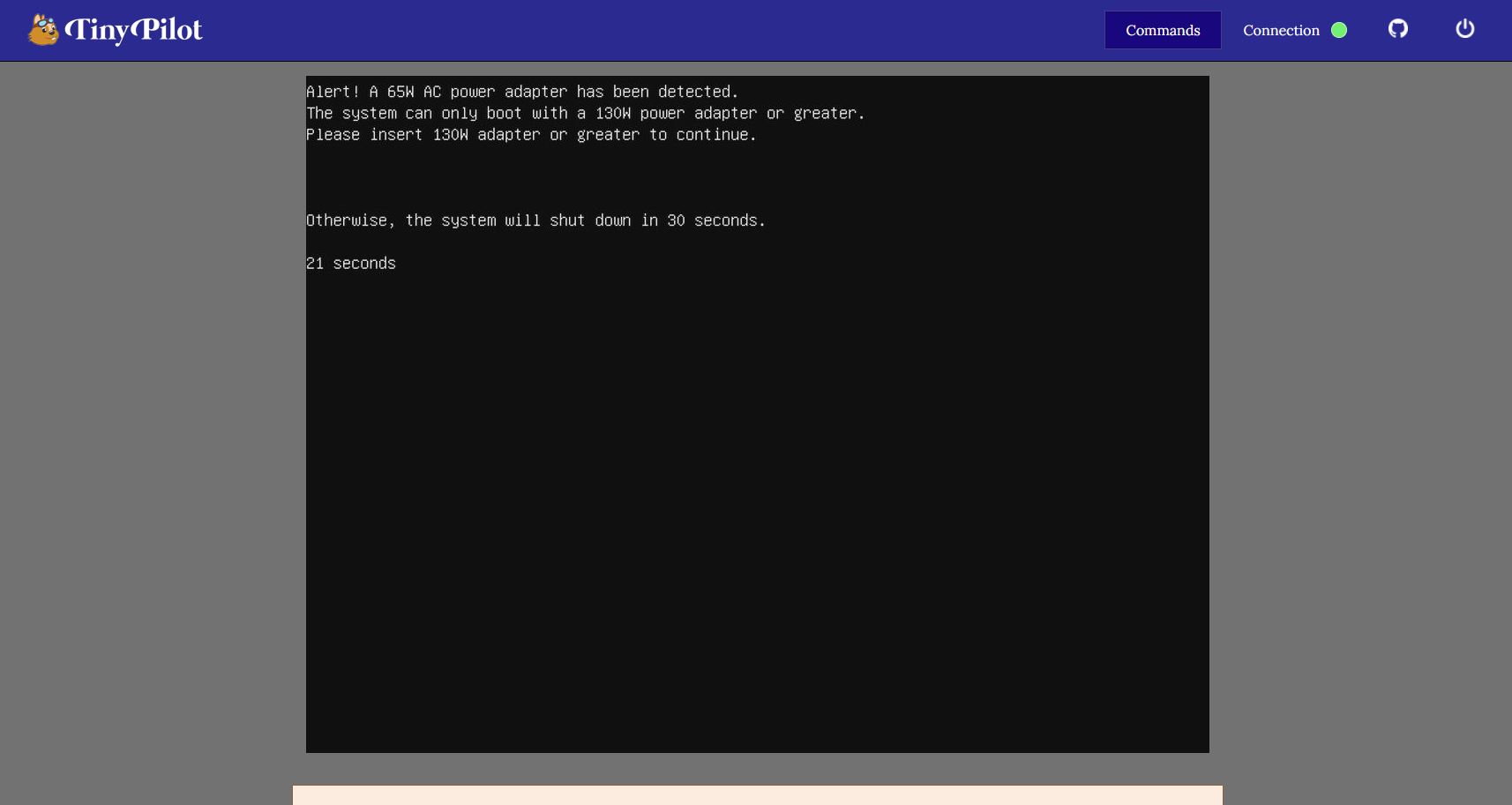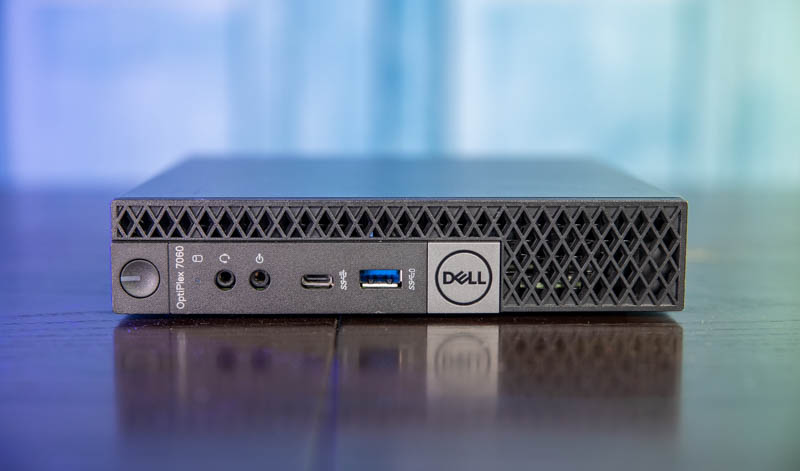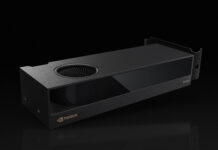Power Consumption
Idle power consumption on 120V power we saw just over 18W idle for the six-core units. We generally assume these nodes will use 9-12W idle for a 35W TDP CPU unit. This was a bit higher than we were expecting, but that is what we saw.
The power supplies are 130W Dell power adapters from the company’s notebook line. This makes sense given the power consumption we saw. We were able to get power fairly easily to exceed 80W without extreme USB-C charging or other power-hungry features. Normally with a Core i5-8500T model, we might expect this to be around 60W. While tens of watts are not big differences in modern large servers, we are seeing a bit over a third more power used at the top end. The 130W power supply is needed because beyond the CPU, one can add more devices than we have so 90W is not going to be sufficient.

Noise wise, at 1m idling, the system was similar to the lower-TDP units we tested. Under load, one can tell that the single fan was pushing more air through that upgraded heatsink due to the hotter CPU. This is certainly more noticeable than the 35W TDP versions. Personally, I think it would be uncomfortable to have a stack of three of these systems on your desk running at 50-100% load all the time.
Next, we are going to discuss key lessons learned before getting to our final thoughts.
Key Lesson Learned for TMM
In this series, we wanted to also focus on some key lessons learned. Since we have already tested well over a dozen different models, we are taking away key pieces of advice from each that we wanted to share.
The configuration we received for $325 was not bad. We had an Intel Core i5-8500 which at the time was around half of that price used. We also had the hard drive, RAM, the system with WiFi, and Windows 10 Pro. We would not call this a top-tier deal, but it was far from poor. Frankly the hard drive we expected to replace. The RAM was a disappointment as two 4GB DIMMs basically both need to be replaced in a system like this. 6 cores and 8GB of memory feels a bit low when the goal of Project TinyMiniMicro is to have many small low-cost cluster nodes for virtualization or even as desktops/ stealth labs. Having a single 8GB DIMM would have been better as that would be less expensive to upgrade.
The one big issue is the power supply. Our unit was listed as coming with a “Dell power supply” but it was a 65W adapter. With the 65W CPU, one needs a 130W power adapter to even boot with the system. If we had a 35W TDP CPU, this system would have expected a 90W PSU.

The seller’s response was “it came with a Dell power supply, the capacity was not stated in the listing”. As a result, the key Project TinyMiniMicro lesson learned is to confirm that the adapter you are getting is sufficient for the unit you are purchasing. This is another caveat emptor Project TMM lesson, and there is a theme there.
Final Words
Part of the reason we purchased this node was to see if the higher power CPU is worth it. After testing this Dell OptiPlex 7060 Micro with a 65W TDP CPU, and having tested many systems with the 35W “T” version of the same processor, the results are mixed, but about what you would expect.

We get a lot more performance by letting the CPUs hit higher clock speeds and use more power. At the same time, we use more power, generate more heat, and thus also create more noise. Having a single unit, especially at lower loads is not too bad, and it is certainly nice to have more performance. Still, if you wanted to have a stack of these nodes in your office, that is possible with the 35W nodes whereas this would likely be too much noise and heat for that type of deployment.
The system itself has Dell’s normal build quality. This is about the generation where we saw Lenovo make a substantial jump in serviceability. The Lenovo systems are a bit easier to work on than this, but we may give a slight edge in this generation to Dell over HP.




Great Review, you caught all the highlights! I am jealous of the equipment & pricing you find, but definitely could not handle your workload. I know this is a lot of work & passion with you, so thank you for all you do for your STH community. Best Regards, ABQ (Steve:)
I hope you posted suitable and detailed feedback for the online seller who shipped the unit with a power supply that was not compatible and then refused to fix the error. I personally think such a business practice is unethical and the seller should suffer consequences. One thing is to make a mistake; it’s another to make a business practice out of not fixing those mistakes.
As I don’t believe such business practices are common (at least in the United States) and so others don’t accidentally buy from the same seller, who was the seller?
Ebay would take your side if you want to return it.
Saying “dell power supply” is meaningless if it flat out -cant- be used with the product.
Great review. I happen to have two of these collecting dust. Could I replace the M.2 wifi/bt with a gigabit ethernet?
In several of your Mini/Micro videos, you mention the difference between network chipsets when discussing model differences. The explanation provided is a bit vague. One important difference is VLAN/QOS support. The Intel chipset supports VLAN/QOS. Cheaper chipsets may not. Although this probably isn’t important for anyone using the system as a desktop, home server enthusiasts might get some use out of this feature.